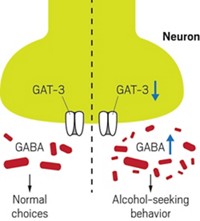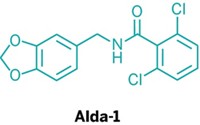Advertisement
Grab your lab coat. Let's get started
Welcome!
Welcome!
Create an account below to get 6 C&EN articles per month, receive newsletters and more - all free.
It seems this is your first time logging in online. Please enter the following information to continue.
As an ACS member you automatically get access to this site. All we need is few more details to create your reading experience.
Not you? Sign in with a different account.
Not you? Sign in with a different account.
ERROR 1
ERROR 1
ERROR 2
ERROR 2
ERROR 2
ERROR 2
ERROR 2
Password and Confirm password must match.
If you have an ACS member number, please enter it here so we can link this account to your membership. (optional)
ERROR 2
ACS values your privacy. By submitting your information, you are gaining access to C&EN and subscribing to our weekly newsletter. We use the information you provide to make your reading experience better, and we will never sell your data to third party members.
Biochemistry
Researchers link taurine metabolic enzyme to mouse weight
The hydrolase may become a drug target for metabolic syndrome
by Laurel Oldach
August 14, 2024
| A version of this story appeared in
Volume 102, Issue 25
Making sense of metabolism, the networks of chemical reactions that keep life alive, can be a challenge because it is hard to study a single molecule in isolation. But if researchers can find enzymes that break down specific molecules, says chemical biologist Jonathan Long, they can get better insight. Drawing inspiration from cat food, researchers in Long’s laboratory at Stanford University have found an enzyme that breaks down a modified version of the amino acid taurine. Manipulating the enzyme helped them find a role for the metabolite in mouse feeding and body mass (Nature 2024, DOI: 10.1038/s41586-024-07801-6).
Humans usually obtain taurine, an amino acid that is not used to make proteins, from dietary sources such as meat (and, recently, energy drinks), although it can also be made from cysteine. Researchers have found a number of secondary taurine metabolites—modified versions of the molecule—some of which have signaling roles.

When a 2012 study identified a previously unknown taurine metabolite, N-acetyltaurine, it piqued Long’s interest (J. Biol. Chem., DOI: 10.1074/jbc.M111.312199). A hunch that this molecule was important led Long’s team to look for an enzyme that could break down N-acetyltaurine into its component parts, acetate and taurine. After fractionating many mouse tissues, the researchers found such an enzyme.
Genetic studies in humans have linked the gene encoding the enzyme to high body mass and obesity. But the gene product’s function, Long says, had been “totally unstudied.” The researchers confirmed biochemically that the enzyme, PTER, hydrolyzes N-acetyltaurine specifically. Then they obtained mice that lacked the hydrolase, and should therefore have more of the metabolite.
At first, this metabolic switch made no apparent difference to the mice. Then, after noticing taurine on a list of cat food ingredients, the researchers analyzed some of their mouse chow with mass spectrometry. The feed, which is made from plants, contains no taurine. Long says that kind of curiousity and creativity powered the whole study. “There was no road map,” he says. “Real science is just, like, wondering what the hell’s going on and having some ideas and trying weird stuff.”
After the researchers gave the animals a taurine supplement, the enzyme’s role leaped into view. Animals without the enzyme had more plasma N-acetyltaurine and tended to eat less and gain less weight on a high-fat diet. Meanwhile, giving wild-type mice on the same diet an injection of N-acetyltaurine also led them to eat less. The researchers found some evidence that N-acetyltaurine may act as a signal in a brain stem region linked to feeding.
Alan Saghatelian, a chemical biologist at the Salk Institute for Biological Studies, calls the study “foundational,” praising the way it unites a new enzyme and a little-studied metabolite to help explain previously puzzling human studies. But others are more measured. Qi-Qun Tang, whose lab at Fudan University studies fat cell development and signaling, finds the enzyme identification impressive but points out that unmodified taurine was already known to affect signaling in fat cells. While studies like this often prompt a rush to find a commercial angle and a weight-loss story, Tang adds, he recommends moderation.
The researchers did not determine how N-acetyltaurine is produced or exactly how it acts in the brain. But even with major questions remaining, the finding may accelerate public interest in taurine supplements, which took off after a 2023 Science paper showed that taurine deficiency drives aging in many animal species (DOI: 10.1126/science.abn9257). Researchers have not confirmed that finding in humans, although clinical studies are in the works.
Long is less interested in nutraceuticals than in the hydrolase’s potential as a drug target for metabolic syndrome. His lab is now working on inhibitors. One possible liability is that the brain region where N-acetyltaurine appears to act is linked to nausea, which is difficult to measure in mice. But if they can find a way to block the hydrolase and avoid side effects, researchers could add a new type of drug to the lucrative weight-loss class.




Join the conversation
Contact the reporter
Submit a Letter to the Editor for publication
Engage with us on Twitter